Giáo án Tiếng Anh Lớp 6 - Chương trình cả năm - Trần Quốc Tuấn
I. Objectives:
- By the end of the lesson, Ss will be able to greet each other, introduce their names and practise it in meaningful way.
II. Teaching aids:
- Text book, pictures, cassette.
III. Teaching process:
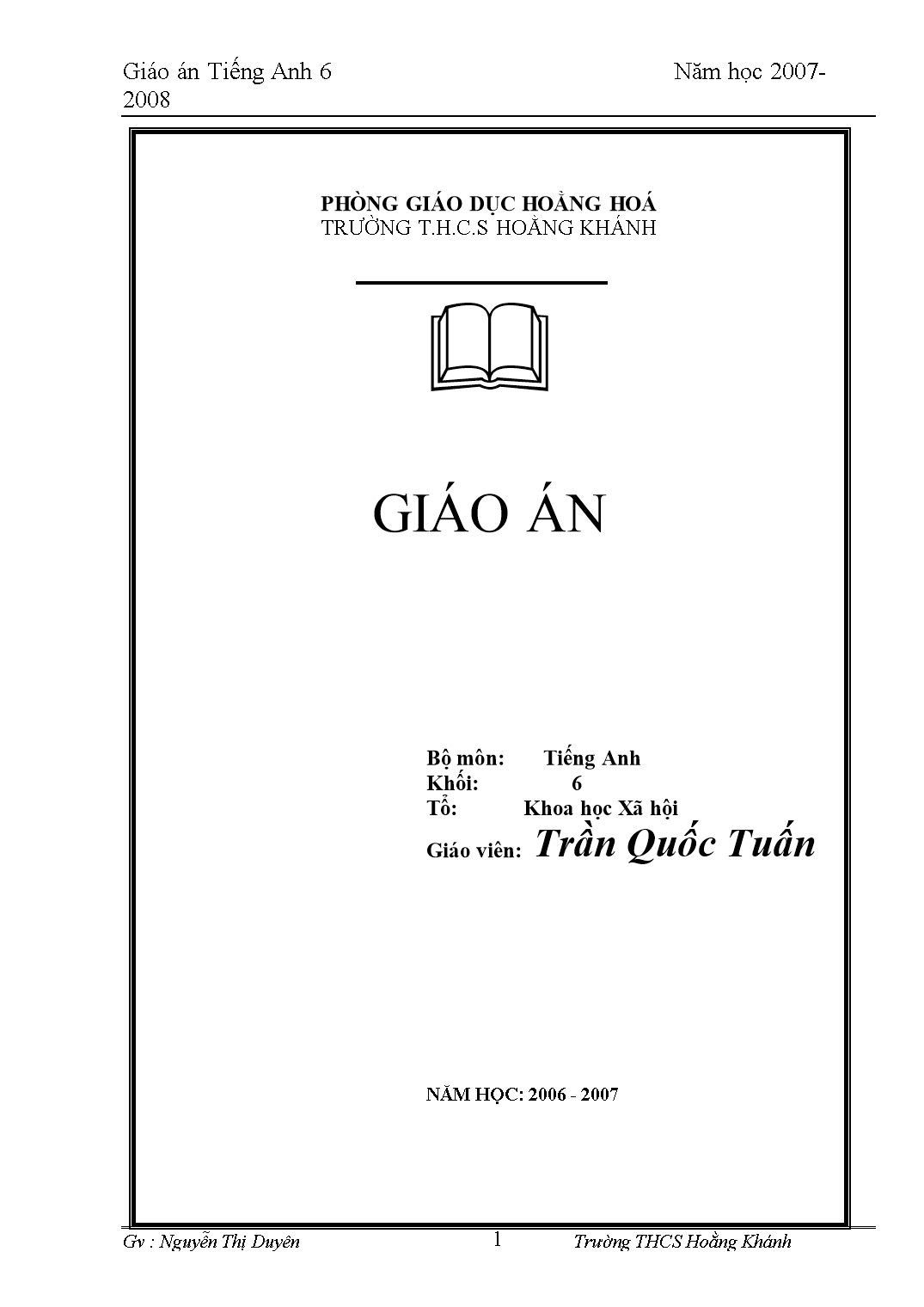
Trang 1
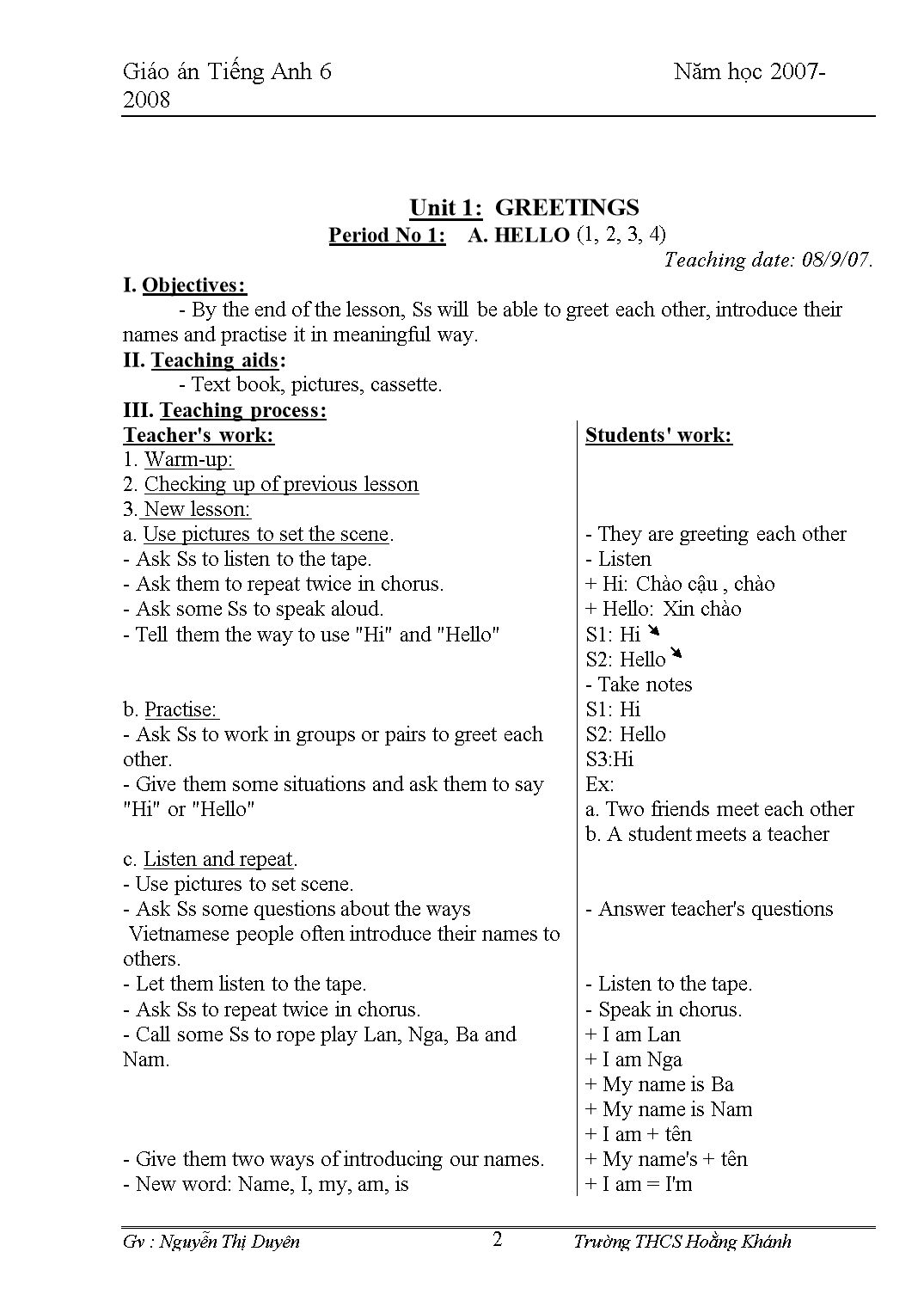
Trang 2
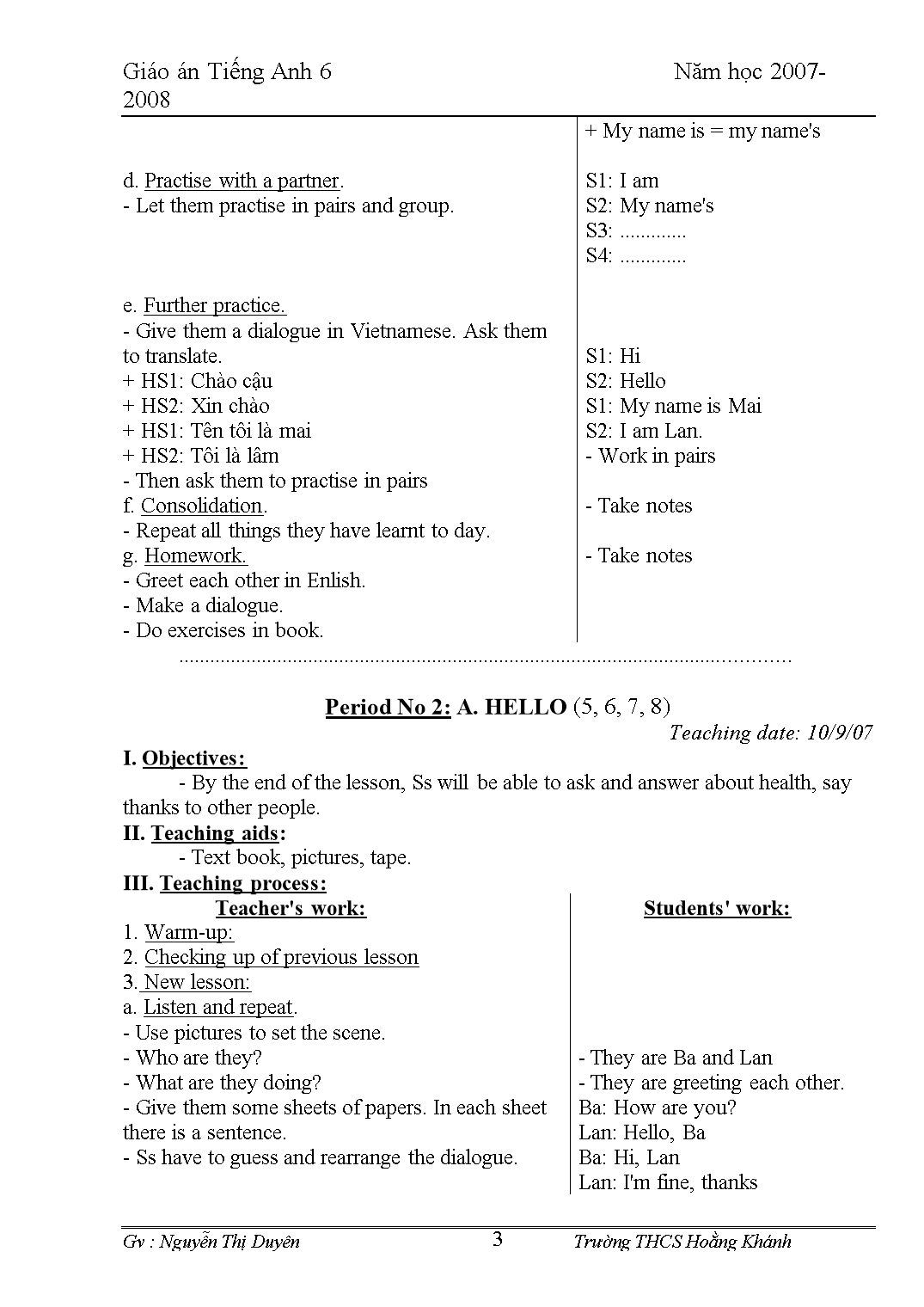
Trang 3
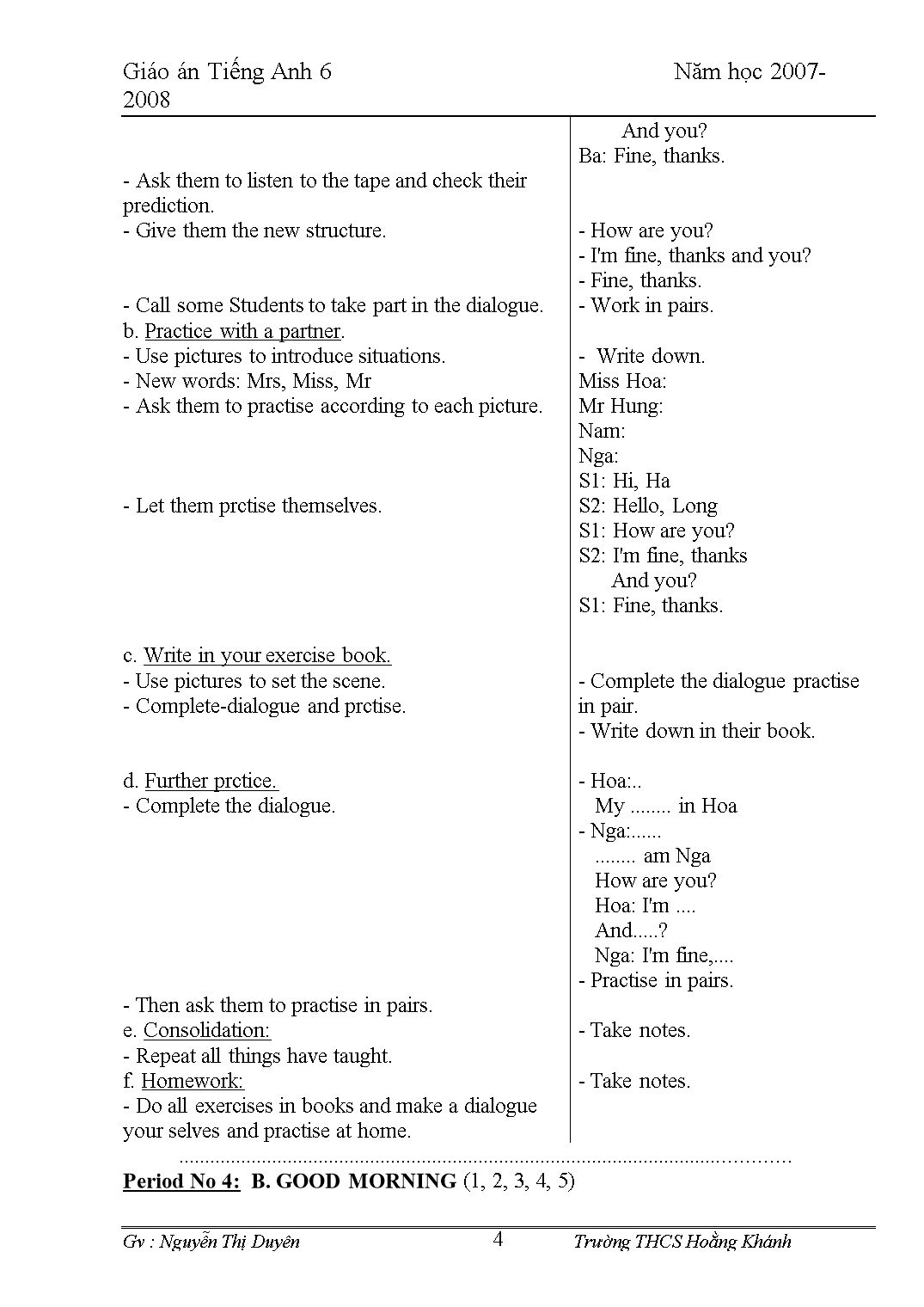
Trang 4
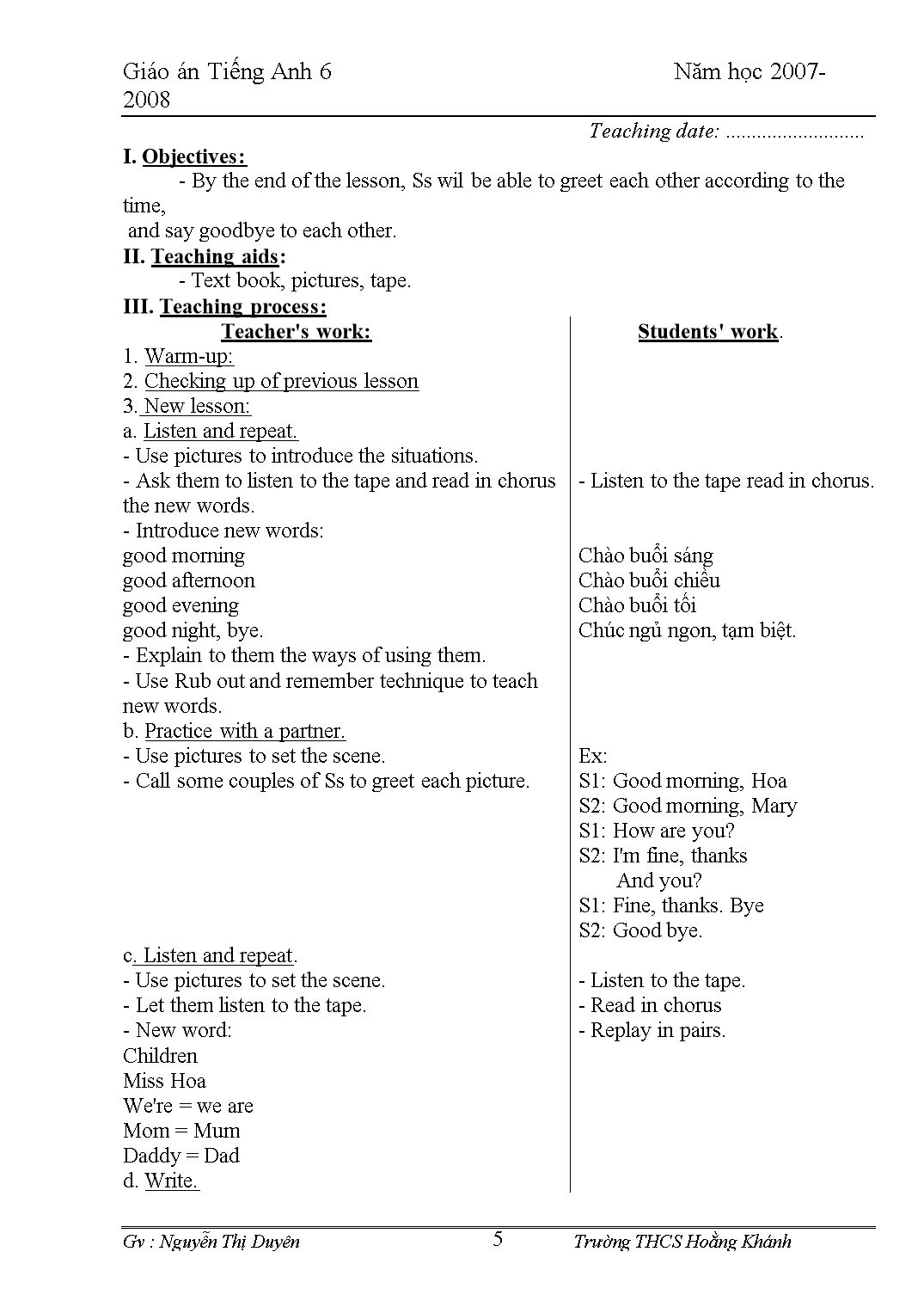
Trang 5
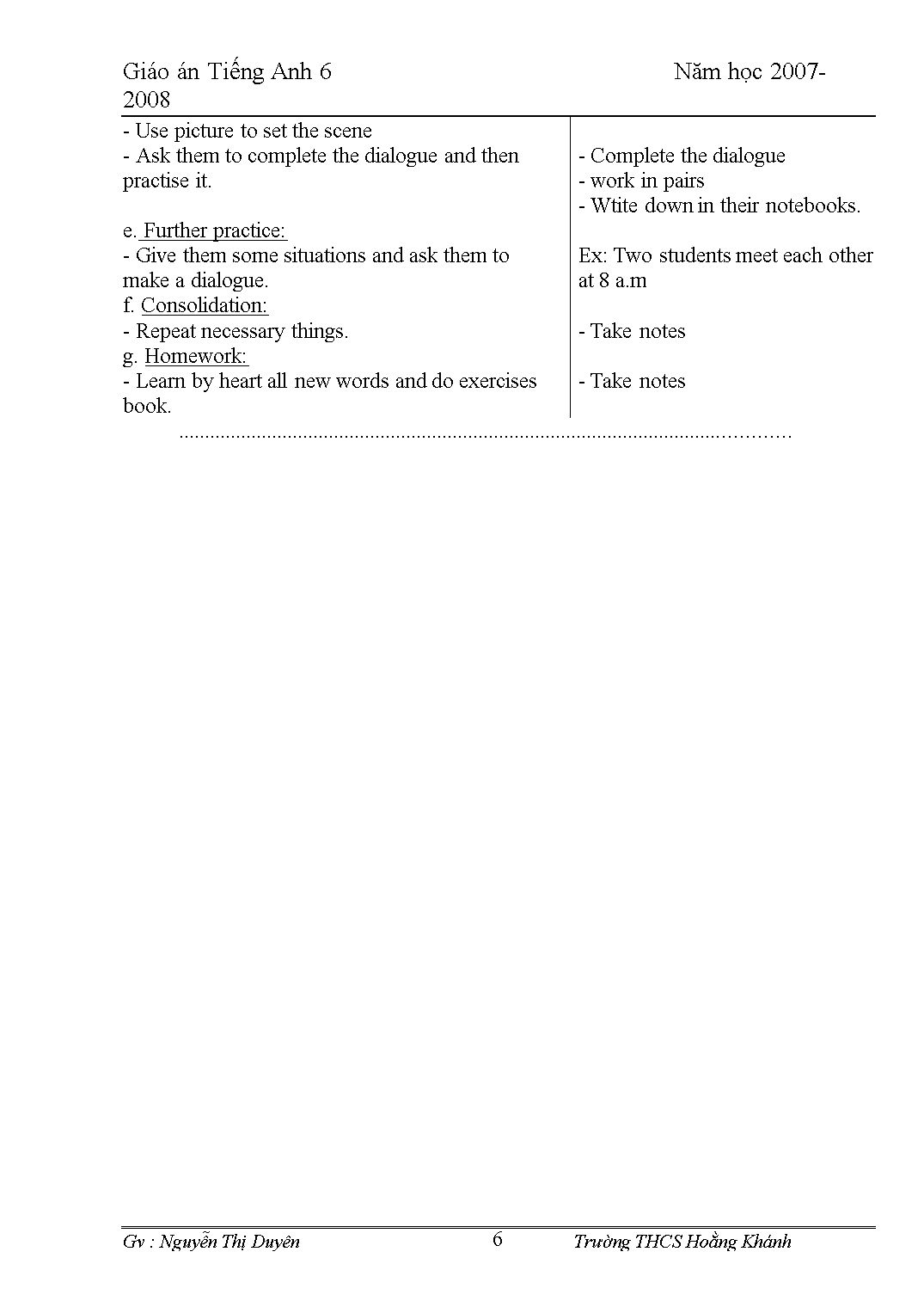
Trang 6
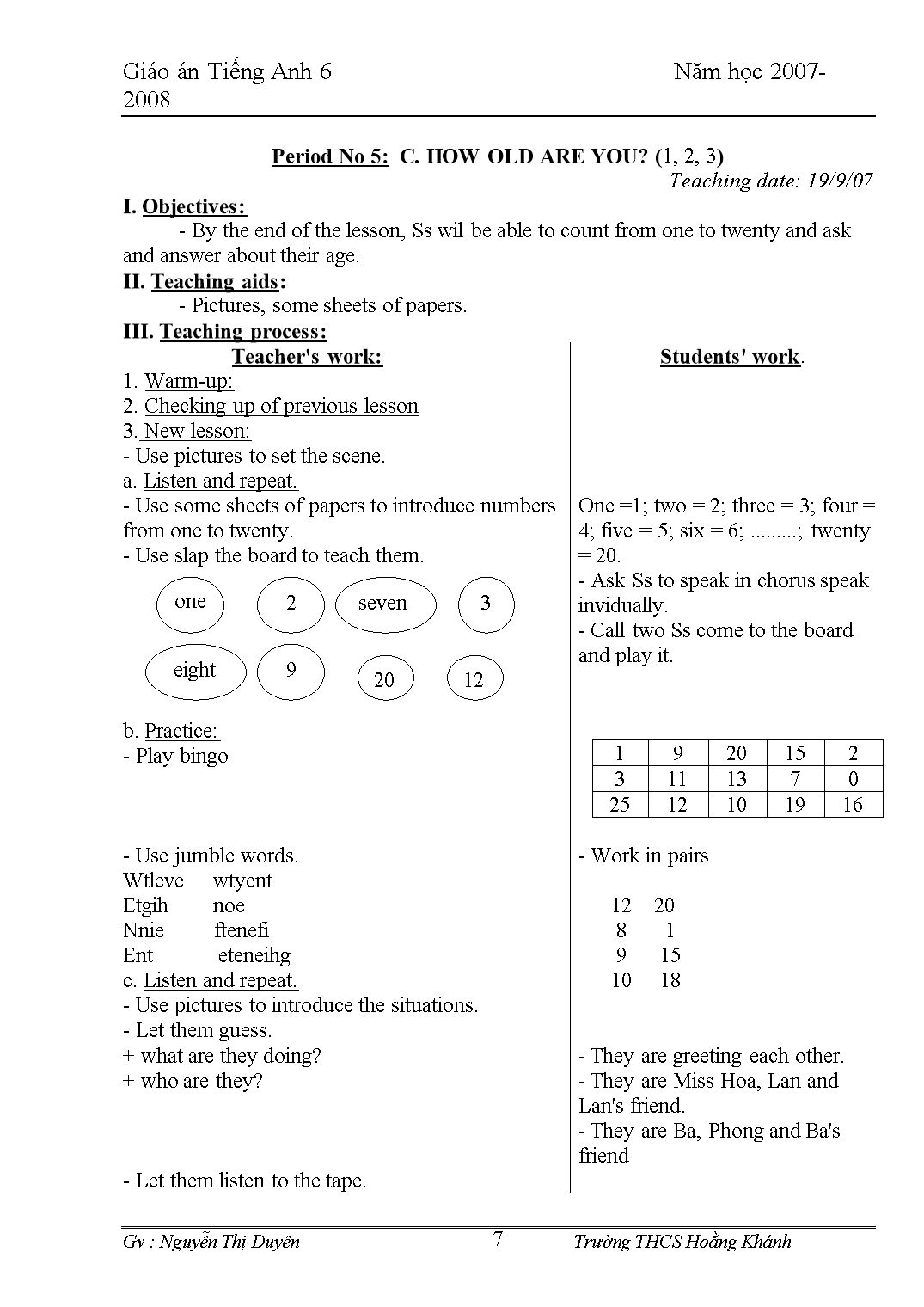
Trang 7
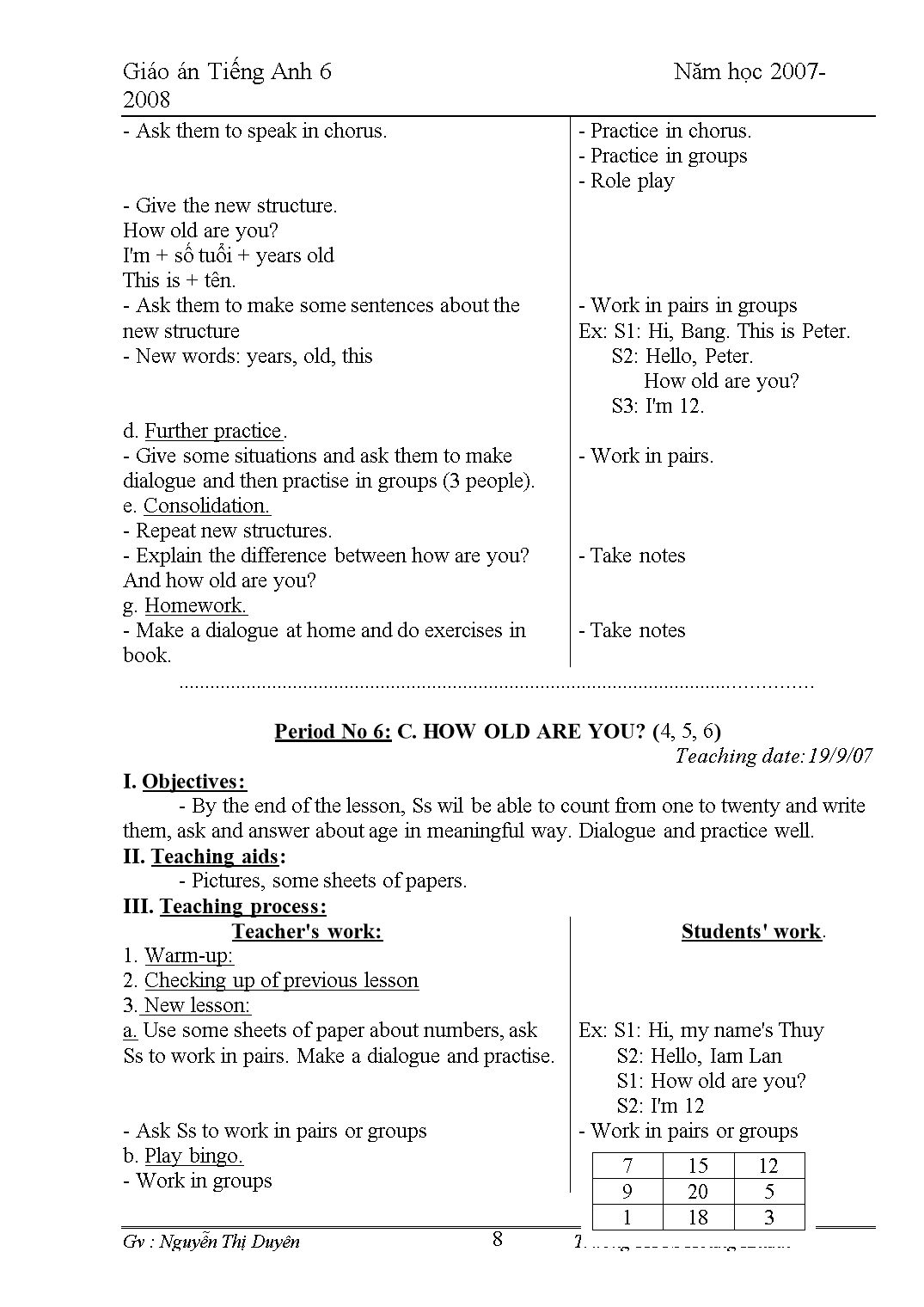
Trang 8
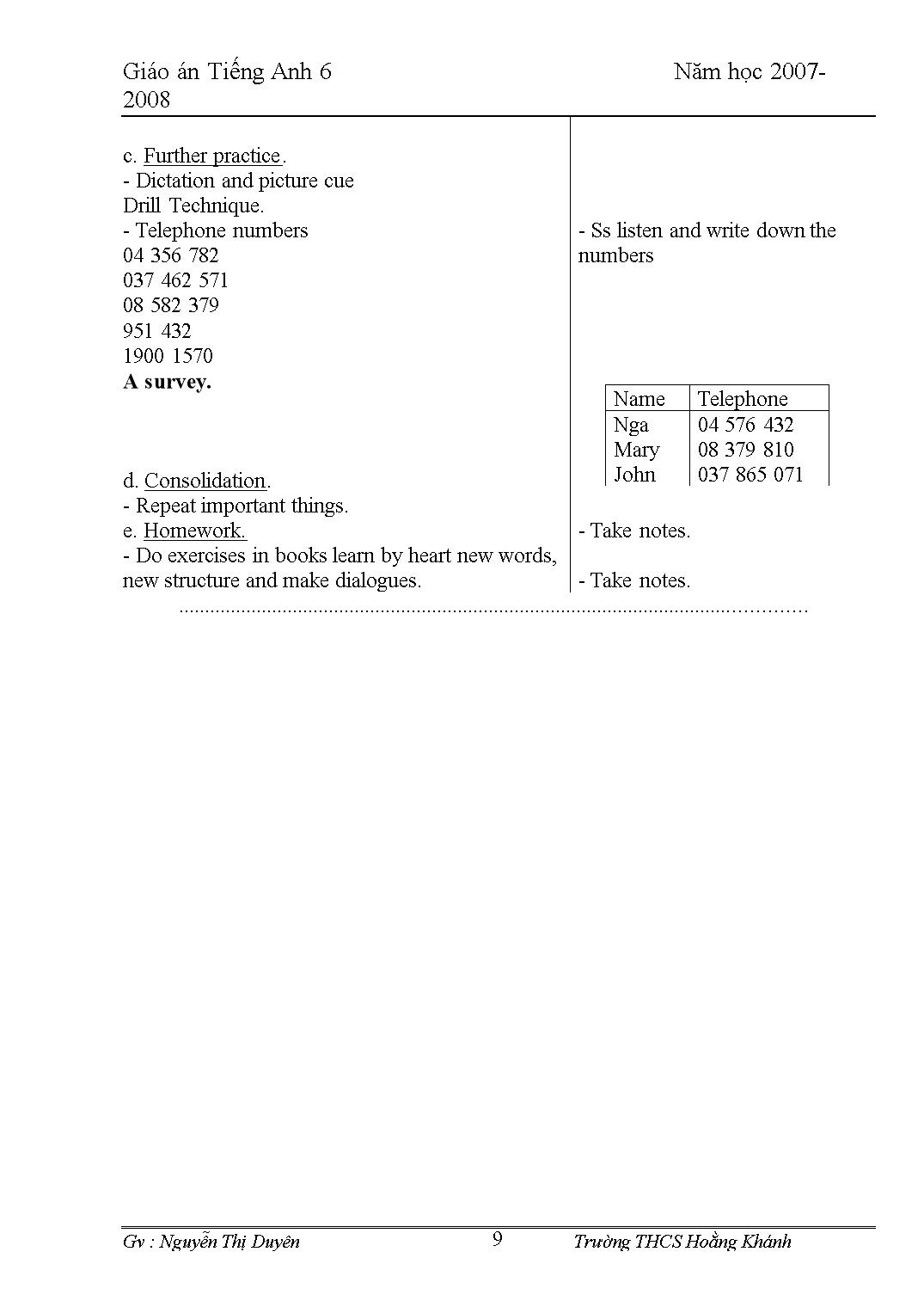
Trang 9
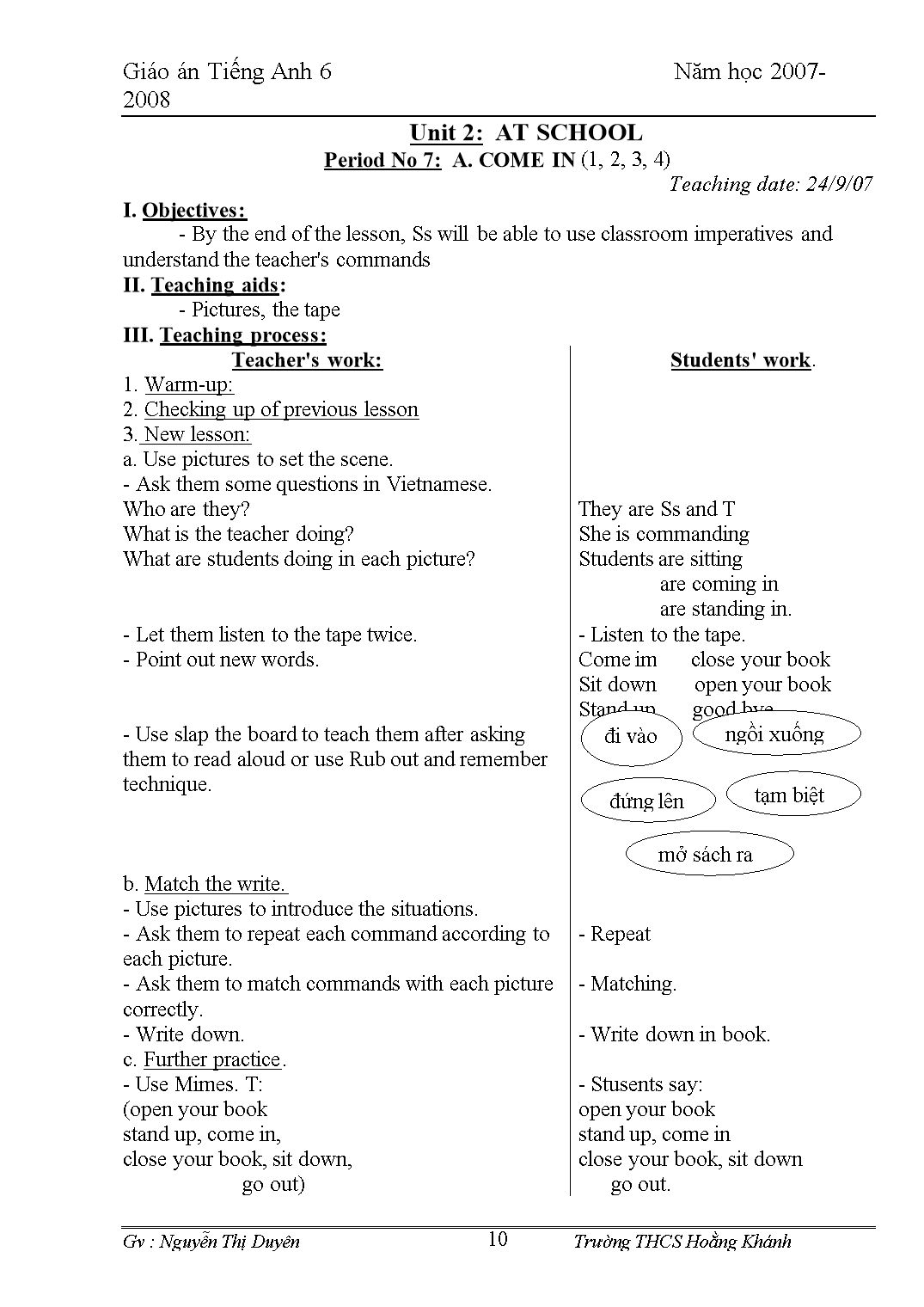
Trang 10
Tải về để xem bản đầy đủ
Bạn đang xem 10 trang mẫu của tài liệu "Giáo án Tiếng Anh Lớp 6 - Chương trình cả năm - Trần Quốc Tuấn", để tải tài liệu gốc về máy hãy click vào nút Download ở trên
Tóm tắt nội dung tài liệu: Giáo án Tiếng Anh Lớp 6 - Chương trình cả năm - Trần Quốc Tuấn
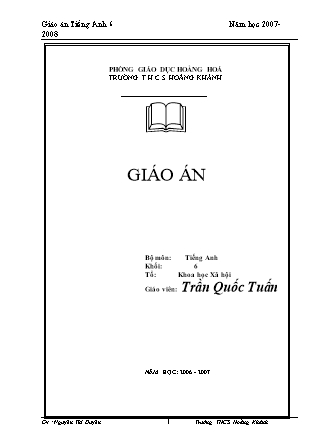
PHÒNG GIÁO DỤC HOẰNG HOÁ
TRƯỜNG T.H.C.S HOẰNG KHÁNH
&
GIÁO ÁN
Bộ môn: Tiếng Anh
Khối: 6
Tổ: Khoa học Xã hội
Giáo viên: Trần Quốc Tuấn
NĂM HỌC: 2006 - 2007
Unit 1: GREETINGS
Period No 1: A. HELLO (1, 2, 3, 4)
Teaching date: 08/9/07.
I. Objectives:
- By the end of the lesson, Ss will be able to greet each other, introduce their names and practise it in meaningful way.
II. Teaching aids:
- Text book, pictures, cassette.
III. Teaching process:
Teacher's work:
1. Warm-up:
2. Checking up of previous lesson
3. New lesson:
a. Use pictures to set the scene.
- Ask Ss to listen to the tape.
- Ask them to repeat twice in chorus.
- Ask some Ss to speak aloud.
- Tell them the way to use "Hi" and "Hello"
b. Practise:
- Ask Ss to work in groups or pairs to greet each other.
- Give them some situations and ask them to say "Hi" or "Hello"
c. Listen and repeat.
- Use pictures to set scene.
- Ask Ss some questions about the ways
Vietnamese people often introduce their names to others.
- Let them listen to the tape.
- Ask Ss to repeat twice in chorus.
- Call some Ss to rope play Lan, Nga, Ba and Nam.
- Give them two ways of introducing our names.
- New word: Name, I, my, am, is
d. Practise with a partner.
- Let them practise in pairs and group.
e. Further practice.
- Give them a dialogue in Vietnamese. Ask them to translate.
+ HS1: Chào cậu
+ HS2: Xin chào
+ HS1: Tên tôi là mai
+ HS2: Tôi là lâm
- Then ask them to practise in pairs
f. Consolidation.
- Repeat all things they have learnt to day.
g. Homework.
- Greet each other in Enlish.
- Make a dialogue.
- Do exercises in book.
Students' work:
- They are greeting each other
- Listen
+ Hi: Chào cậu , chào
+ Hello: Xin chào
S1: Hi
S2: Hello
- Take notes
S1: Hi
S2: Hello
S3:Hi
Ex:
a. Two friends meet each other
b. A student meets a teacher
- Answer teacher's questions
- Listen to the tape.
- Speak in chorus.
+ I am Lan
+ I am Nga
+ My name is Ba
+ My name is Nam
+ I am + tên
+ My name's + tên
+ I am = I'm
+ My name is = my name's
S1: I am
S2: My name's
S3: .............
S4: .............
S1: Hi
S2: Hello
S1: My name is Mai
S2: I am Lan.
- Work in pairs
- Take notes
- Take notes
.....................................................................................................................
Period No 2: A. HELLO (5, 6, 7, 8)
Teaching date: 10/9/07
I. Objectives:
- By the end of the lesson, Ss will be able to ask and answer about health, say thanks to other people.
II. Teaching aids:
- Text book, pictures, tape.
III. Teaching process:
Teacher's work:
1. Warm-up:
2. Checking up of previous lesson
3. New lesson:
a. Listen and repeat.
- Use pictures to set the scene.
- Who are they?
- What are they doing?
- Give them some sheets of papers. In each sheet there is a sentence.
- Ss have to guess and rearrange the dialogue.
- Ask them to listen to the tape and check their prediction.
- Give them the new structure.
- Call some Students to take part in the dialogue.
b. Practice with a partner.
- Use pictures to introduce situations.
- New words: Mrs, Miss, Mr
- Ask them to practise according to each picture.
- Let them prctise themselves.
c. Write in your exercise book.
- Use pictures to set the scene.
- Complete-dialogue and prctise.
d. Further prctice.
- Complete the dialogue.
- Then ask them to practise in pairs.
e. Consolidation:
- Repeat all things have taught.
f. Homework:
- Do all exercises in books and make a dialogue your selves and practise at home.
Students' work:
- They are Ba and Lan
- They are greeting each other.
Ba: How are you?
Lan: Hello, Ba
Ba: Hi, Lan
Lan: I'm fine, thanks
And you?
Ba: Fine, thanks.
- How are you?
- I'm fine, thanks and you?
- Fine, thanks.
- Work in pairs.
- Write down.
Miss Hoa:
Mr Hung:
Nam:
Nga:
S1: Hi, Ha
S2: Hello, Long
S1: How are you?
S2: I'm fine, thanks
And you?
S1: Fine, thanks.
- Complete the dialogue practise in pair.
- Write down in their book.
- Hoa:..
My ........ in Hoa
- Nga:......
........ am Nga
How are you?
Hoa: I'm ....
And.....?
Nga: I'm fine,....
- Practise in pairs.
- Take notes.
- Take notes.
.....................................................................................................................
Period No 4: B. GOOD MORNING (1, 2, 3, 4, 5)
Teaching date: ...........................
I. Objectives:
- By the end of the lesson, Ss wil be able to greet each other according to the time,
and say goodbye to each other.
II. Teaching aids:
- Text book, pictures, tape.
III. Teaching process:
Teacher's work:
1. Warm-up:
2. Checking up of previous lesson
3. New lesson:
a. Listen and repeat.
- Use pictures to introduce the situations.
- Ask them to listen to the tape and read in chorus the new words.
- Introduce new words:
good morning
good afternoon
good evening
good night, bye.
- Explain to them the ways of using them.
- U ... :
- Learn by heart new vocabulary
- Make sentences using new form
- Do exercise in book
Students' work:
Write down
Listen and repeat
- Look at picture
a. They are going to visit Huong Pagoda
b. They are going to travel by minibus
c. They are going to bring some food and drinks,.....
- Listen
- Practice in groups
S2: That's a good idea
No, I don't want to .....
Yes, let's + V
That's a good idea
Great!
Yes, let's + V.....
No, ..........
Ex: S1: Let's going fishing
S2: That's a good idea
S1: Why don't we practising music?
S2: Yes, let's practise it
S1: What about having a picnic
S2: No, I don't have a tent
Look at pictures
They are having a bath or they are swimming
They are going shopping
They are playing volleyball
They are going to the zoo
They are playing badminton
They are having a picnic
They are going camping
Practice in pairs
Practice in pairs
Ex: S1: What does Nam want to do?
S2: He wants to go to Hue
- Write the answers in book
- Take notes
..................................................................................................
Period No 89: GRAMMAR PRACTICE
Teaching date:........................
I. Objectives:
- By the end of the lesson, Ss will be able to use "to be going to + V" position statements and "Wh" questions, to talk about vacation plans.
II. Teaching aids:
- Pictures, the tape, the stereo.
III. Teaching process:
Teacher's work:
A. Warm-up:
B. Checking up of previous lesson
C. New lesson:
1. Present simple tense:
a. Set the scene:
Do you like sports?
What sports do you play?
Do you play volleyball?
b. Ask them to complete the dialogues:
c. Cmplete the dialogue
- Observe:
- Check and correct.
- Ask them to write down the answer in book.
2. Adverbs of frequency:
- Ask them to recall some adverbs of frequency:
- Ask them to make sentences
- Ask them to practice in pairs
- Use Noughts and Crosses T:
Students' work:
Answer:
a. Huong: Do.....
Ba: .....like
Huong: sports do....
Ba: play.....
Huong: Do...
Ba: .....don't
b. Thu: Does.............
Tuan: ......does. ........like
Thu: ........sports does
Tuan: plays
Thu: Does...........
Tuan: doesn't
c. Minh: Do ..........
Ha: do
Minh: sports do.....
Ha: ........
Minh: ......
Ha: ........don't
Example:
S1: How often do you {go to the movies}?
S2: {Twice a year}
TV
the movies
go to thestore
swimming
help your mom
go fishing
table tennis
go camping
play badmonton
- Work in groupd or pairs
3. Present progressive tense:
- Ask them to recall the form of this tense:
Ex: I am watching TV
We are not playing games
Are you cooking dinner?
Yes, I am
No, I am not
What are they doing?
They are playing volleyball
- Ask them to cmplete the dialogues in book.
- Observe
- Check and correct
4. Further "going to":
- Ask them to recall the form and the usage this tense:
Ex: We are going to be useful citizens
He is going to visit his grandparents
- Ask them to look at pictures to answer question:
What are they going to do?
- Check and correct
- Now ask them to complete the dialogue
- Check and correct
- Ask them to write in book.
5. What is the weather like?
- Ask them to answer questions about the weather
- Ask them to write answers in book
6. Future plans:
- Ask them to answer then write the answers in book.
7. Homework:
- Do exercises in book
- Finish all exercises in the text book.
- Review to do a test
S1: How often do you help your mom?
S2: every day or three times a week.
..................
S + to be + V-ing + ......
Are/ Is + S + V-ing......?
Yes, S + tobe
No, S + tobe not
S + tobe + not + V-ing .......
Wh-Q + tobe + S + V-ing.......?
- Complete the dialogues
a. Hung: .........
Mai: ......am watching
Mai: ....playing
Mai: .....is winning.....
b. Vui: .....
Nam: is cooking
Nam: ....aren't
Nam: ....is
c. Nhan: ...
Thanh: ...I am doing...
Nhan: am reading....
[ S + tobe + going to + V(-to).....]
use this tense to make plans what happens in the near future.
Look at the pictures:
a. They are going to play soccer
b. They are going to play tennis
c. They are going to go camping
d. They are going to go swimming
e. They are going to watch TV
f. They are going to cook meal
a. It is warm in the spring
b. It is hot in the summer
c. It is cold in the fall
d. It is cold in the winter
Answer and write the answers in book
Take notes
...........................................................................................................................
Period No 90: WRITTEN TEST 4
Teaching date:........................
I. Em hãy chọn từ cho sẵn điền vào chỗ trống để hoàn thành các câu sau. Mỗi từ chỉ được dùng 1 lần: (3points)
see stay visit play do have
1. What are your family going..........................this weekend?
2. We're going to................................the museum next Saturday.
3. Is Mr Minh going to.......................badminton?
4. She's going to.................................with her uncle in the country.
5. I'm going to....................................a new film with my friends.
6. We are going to..............................dinner with them.
II. Em hãy cho dạng đúng của động từ trong ngoặc để hoàn thành những câu sau: (3 points)
1. You can (park) ______________here because this sign says "Parking".
2. Mary (not work)_________________today because it's Sunday.
3. Where______you (go)_________________?
- I (go)______________the zoo.
4. What________you (do)___________this summer holiday?
- We (visit)______________ Ho Chi Minh City.
III. Em hãy điền a, an, some, any vào mỗi chỗ trống để hoàn thành các câu sau: (3.0 points)
1. I would like .................... dozen eggs.
2. They are planting ........................ trees in the garden.
3. They aren't ....................... pictures in the album.
4. Would you like ....................... coffee?
5. There is ....................... orange in the box.
6. Do you have .................... brothers or sisters?
IV. Em hãy đặt câu hỏi cho phần gạch chân ở mỗi câu sau: (1.0 point)
1. My sister feels hungry.
..................................................................................................................
2. They are going to the zoo.
..................................................................................................................
3. Her eyes are blue.
..................................................................................................................
4. We want two bottles of water.
..................................................................................................................
The answer keys:
I. 1. do; 2. visit; 3. play; 4. stay; 5. see; 6.have.
II. 1. park; 2. isn't working; 3. are you going - am going;
4. are you going to do - are going to visit.
III. 1. a; 2. some; 3. any; 4. some; 5. an; 6. any.
IV. 1. How does your sister feel?; 2. Where are they going?
3. What color are her eyes?; 4. How much water do you want?
..................................................................................................
Unit 15: COUNTRIES
Period No 91: A. WE ARE THE WORLD(1,2,3,4)
Teaching date:........................
I. Objectives:
- By the end of the lesson, Ss will be able to use countries, nationalities and languages vocabulary to talk about where people are from, which languages they speak and what their nationalities are.
II. Teaching aids:
- Pictures, the tape, the stereo.
III. Teaching process:
Teacher's work:
A. Warm-up:
B. Checking up of previous lesson
C. New lesson:
1. Listen and repeat:
- Pre-teach: world, from, speak, Canada, France, China, Great Britain, Australia.
- Use pictures to set the scene.
- Model sentences:
Where is (she/ he) from?
Where are (you/ they) from?
She/ he is from + countries
I am from + countries
We/ they/ you are from + countries
- Ask them to listen to the tape
- Let them repeat
- Ask them to practice
- Ask them to give the form to ask about where people are from.
2. Listen and read:
- Use picture to set the scene:
Who is he?
Where is he from?
Which language does he speak?
- Ask them to listen to the tape
- Read aloudly
Ex: I speak Vietnamese
He speaks Vietnamese
3. Listen and repeat:
Pre- teach:
country, language, nationality
Vietnam -> Vietnamese
Japan -> Japanese
China -> Chinese
Australia -> Australian - English
Great Britain -> British -> English
Canada -> Canadian - > English -> French
- Use Rubout and Remember technique
4.Make dialogues. Practice with a partner:
- Model sentences
What is her/ his nationality?
He/ she is Vietnam/ Chinese/ Canadian
What is your nationality?
I am/ Japanese/ Australian/ British
- Ask them to make examples
-Which language + do/does+she/he/you+speak?
- He/ she speaks Vietnamese
- I speak Japanese
-Ask them to give the form
- Now make the dialogue
- Ask them to work in pairs
- Check and correct
- Ask them to write down
- Ask them to practice in pairs
5. Homework:
- Learn by heart new words
- Make examples using new structures to introduce yourself.
- Do exercises in book.
Students' work:
- Look at pictures
- Write down
- Listen and repeat
- Practice
S1: Where is she from?
S2: She's from Canada
S1: Where are you from?
S2: I'm from Viet Nam
- Listen to the tape
- Repeat
- Practice
Where + tobe + S + from?
S + tobe +from+names of countries.
Look at picture
He is Minh
He is from Vietnam
He speak {Vietnamese}
- Listen to the tape
- Read loudly
-> S + speak(s) + adj (language)
Write down
Listen and repeat
Rubout and Remember technique
- Practice reading and writing
Write down
What is + one's nationality?
S + tobe + adj (nationality)
S1: What is his nationality?
S2: He is American
-> Which language + do/ does + S + speak?
- S + speak(s) + language.
Ex: Which language do you speak?
+ I speak English
-Work in pairs
- Correct
- Write down
- Practice in pairs
Take notes and write down
...........................................................................................................
Unit 15: COUNTRIES
Period No 92: A. WE ARE THE WORLD(5,6)
Teaching date:........................
I. Objectives:
- By the end of the lesson, Ss will be able to practice fruently about where they from, which languages they speak and what their nationalities are. Moreover, they can write a postcard about Being on vacation.
II. Teaching aids:
- Pictures, the tape, the stereo.
III. Teaching process:
Teacher's work:
A. Warm-up: (Slap the board)
-Names of some countries
B. Checking up of previous lesson
C. New lesson:
5. Write the postcard:
-Explain the way to write a postcard.
Date:...............
Dear.....,
.............................................
.............................................
.............................................
Love, Writer’s address
......... .....................
-Let ss read the postcard from Nhan
- Ask ss to answer the questions:
+ Where is Nhan?
+ What’s the weather like?
+ What’s she doing?
+ What’s she going to do tomorrow?
-Get Ss to write a similar postcard.
-Ask Ss to read the postcards.
6. Guide ss to answer the questions and write them on their exercise book.
V. Consolidation:
Quetions about personal information
Writing a postcard.
VI. Home work:
Students' work:
Listen and follow the steps.
Read the post card and answer the questions.
- Ss’ answers.
Write a similar postcard.
Suggestion:
20 June
Dear ......
I am on vacation in...........
The weather is.............and.........
I am travlling by..........and visiting alot of interesting places.
Tomorrow I am going to...........
Love,
........
Unit 15: COUNTRIES
Period No 93: B. CITIES,BUILDINGS AND PEOPLE(1,2)
Teaching date:........................
I. Objectives:
By the end of the lesson, Ss will be able to make comparisons about cities,buildings and poeple.
II. Contents: 1. Grammar: - Comparison ( Comparative & Superlative )
2. Vocab: building, population, million....
III. Teaching aids:
- Pictures, the tape, the stereo.
IV. Teaching process:
Teacher's work:
A. Warm-up:
B. Checking up of previous lesson
C. New lesson:
Listen and read.
- Ask ss where they can see the buildings and houses.
- Ask ss to compare in three to show the biger and the biggest ones.
Vocab: building,house,big,small,tall
Let ss look at the pictures and tell the differences of the following words:
- big --> bigger --> the biggest
- small --> smaller --> the smallest
- tall --> taller --> the tallest
* Comparatives ( So sánh hơn) * Superlatives (So sánh nhất)
a, Short adj: .......adj _er + than....... ..... the + adj_est ......
b, Long adj: ......more + adj _ than...... .....the most + adj ............
EX: - Ho Chi Mimh city is bigger than Hanoi.
- HCM city is the biggest city in Vietnam.
2. Listen and read.Then answer the questions.
-Ask ss to recognise the places in the photos. ( the cities in the world ):
Mexico city London
Vietnam Tokyo
Let ss predict the biggest city.
Vocab: - population
- million
EX: -It has a population of 13,5 million.
- It has a population of 6,3 million.
- Let ss read the paragraph.Then answer the questions:
a, No. It isn’t
b, Mexico city is the biggest city in the world.
c, Tokyo is bigger than London.
- Ask ss read and translate
- Write 4 comparisons about the citiesin Vietnam.
Cities Population
Da nang 2.0 million
Hue 1,8 million
Ha noi 2,8 million
HCM city 3,5 million
V. Home work:
...........................................................................................................
Unit 15: COUNTRIES
Period No 94: B. CITIES,BUILDINGS AND PEOPLE(3,4,5)
Teaching date:........................
I. Objectives:
- By the end of the lesson, Ss will be able to make comparisons of cities,buildings and people in the world.
II. Teaching aids:
- Pictures, the tape, the stereo.
III. Teaching process:
Teacher's work:
A. Warm-up:
B. Checking up of previous lesson
C. New lesson:
3. Listen and read.Then answer the questions.
-Get ss to tell names of some famous places of the cities in the world.
- the London Tower
- the statue of Liberty
- the Eiffel Tower
- Ask ss: Do you know the highest building in the world? What is it?
- Introduce some high buildings in the world:
+ Sears Tower in Chicago ,USA
+ PETRONAS Twin Tower in Kualalumpuar,Malaysia
+ The Great Wall ,China
-Let ss listen and check the figures.
+ Sears Tower 452 meters
+ PETRONAS Twin Tower 12 meters
+ The Great Wall 442 meters
Explain: - It is 442 meters high.
4. Note:
+ It is 442 meters high.
+ It is 6,000 kilometers long.
+ It is 9 meters thick.
Ask ss to translate the paragraphs in to Vietnamese
Ask ss to role play a tourist guide to make speech about the buildings,
V. Consolidation & Home work:
File đính kèm:
 giao_an_tieng_anh_lop_6_chuong_trinh_ca_nam_tran_quoc_tuan.doc
giao_an_tieng_anh_lop_6_chuong_trinh_ca_nam_tran_quoc_tuan.doc

